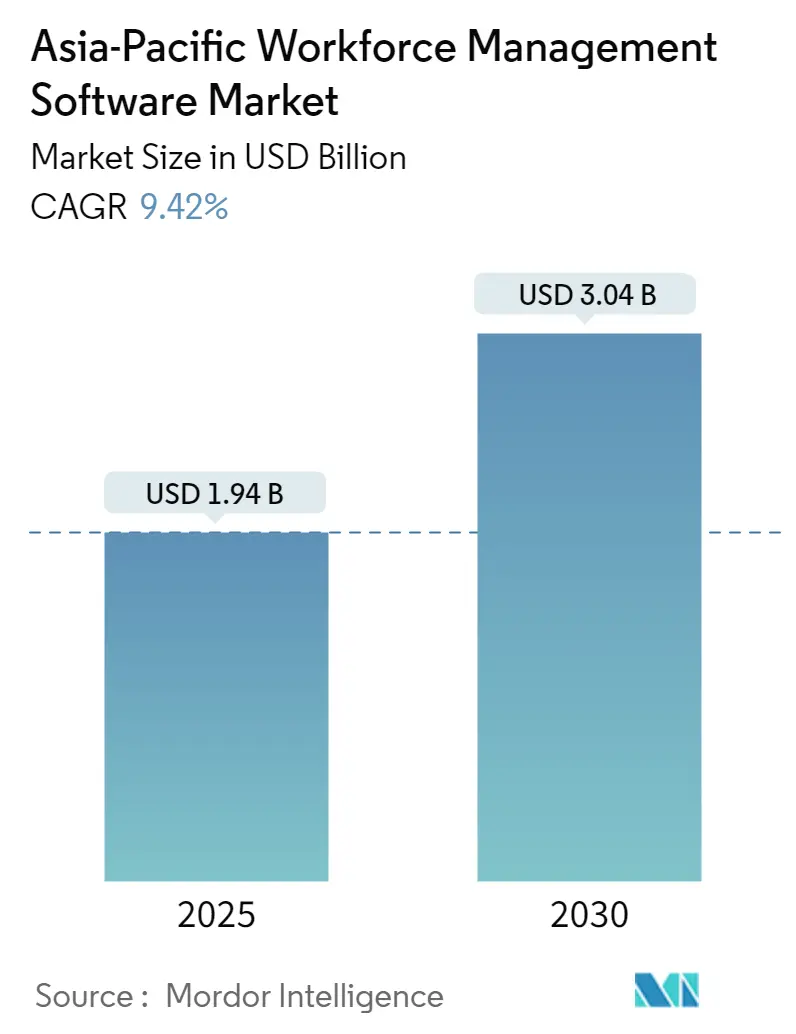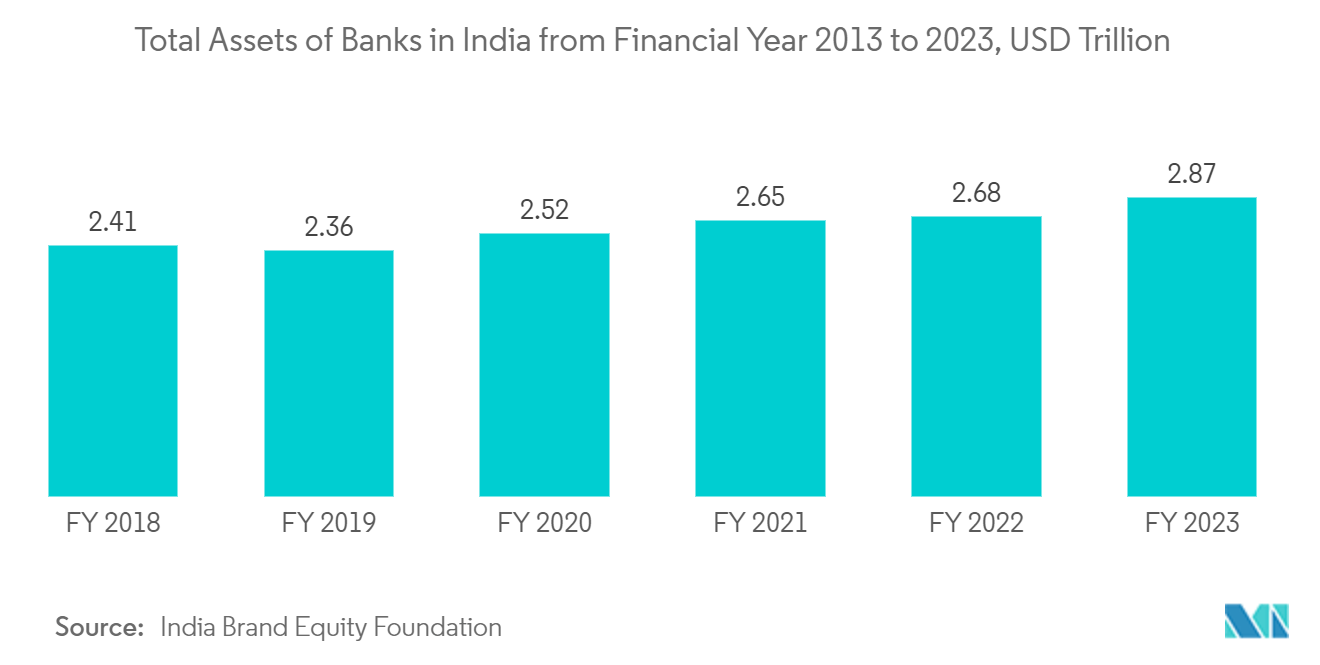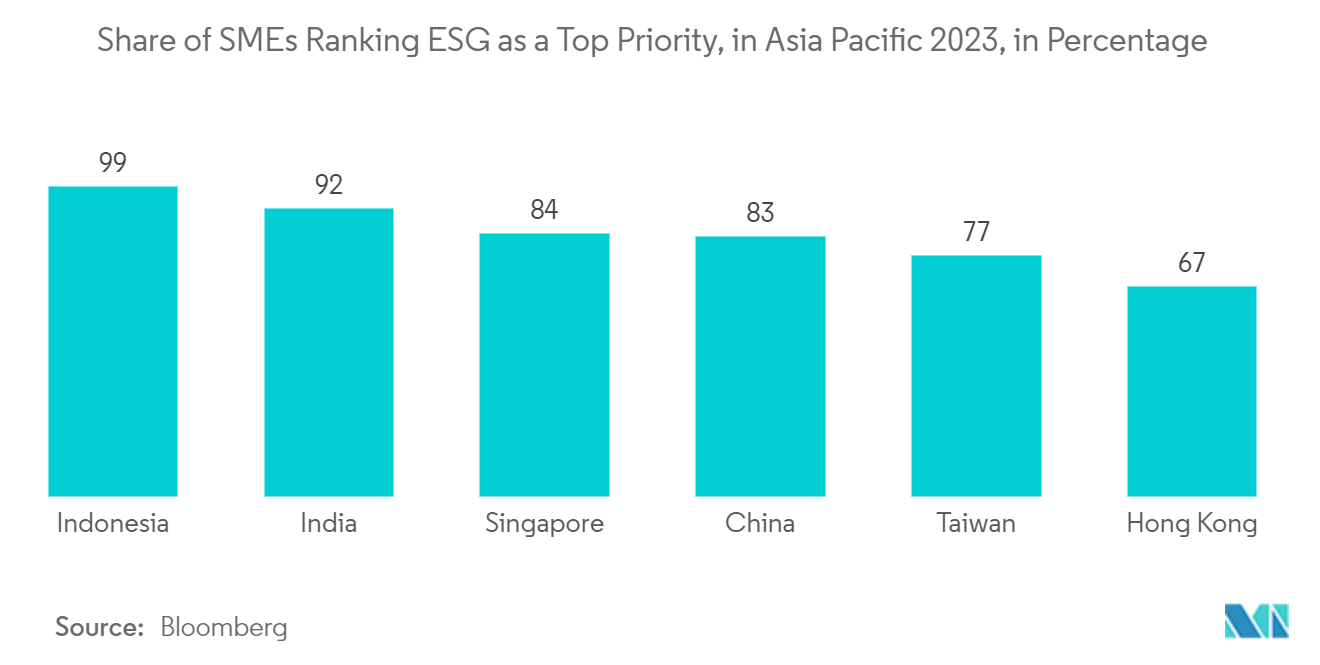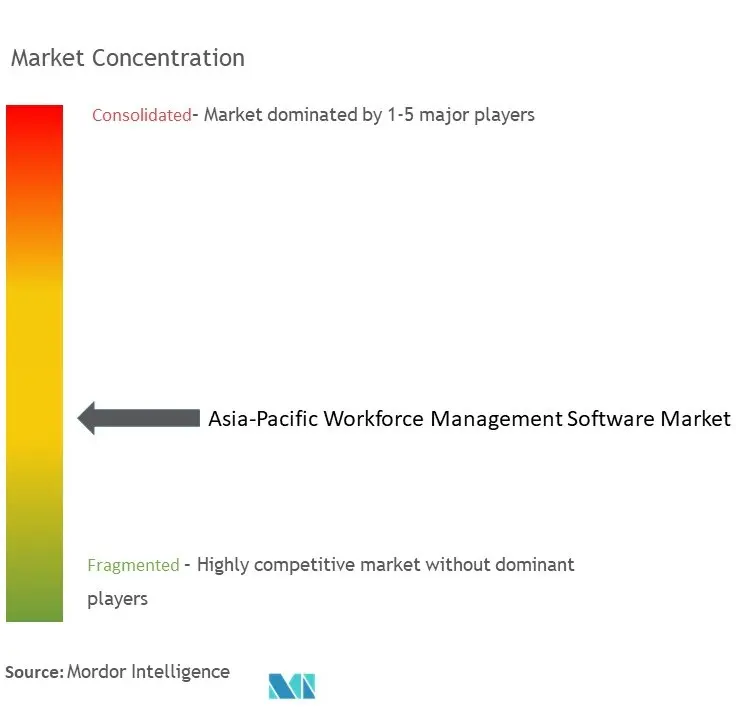
Asia-Pacific Workforce Management Software Market Analysis by Mordor Intelligence
The Asia-Pacific Workforce Management Software Market size is estimated at USD 1.94 billion in 2025, and is expected to reach USD 3.04 billion by 2030, at a CAGR of 9.42% during the forecast period (2025-2030).
By allowing effective administration of work schedules, business processes, labour costs and talent management, workforce management software has an important role to play in improving organisational performance.
- The Asia Pacific region is one of the world's largest producers of goods, and this is due to its position as a major exporter. Different products are manufactured by India, China, South Korea, Indonesia, Japan, and Australia. The region is known for its skilled labour. It's known for software, cars, food production, medicines, cosmetics, machinery, clothes and many other products produced here. The workforce is very critical in terms of production and advanced capabilities.
- Employees are increasingly using self service technologies, which can be reached from any location and with no major obstacles, as a result of increasing use of automation based processes. Such technologies are enabling more transparency and communication in the workplace, while preserving a chain of command.
- In the field of workforce management software, use of AI is also becoming more widespread. Several businesses are using artificial intelligence to reduce the time consuming tasks, such as recruitment and hiring, planning and tracking times.
- There are millions of physicians, engineers, technicians, etc. in this region. Converting such a large number of educated workers into a skilled workforce requires a management system. The key to success in any organization is productivity. Enterprises and industry are working towards cost reduction, productivity improvement as well as improving business process efficiency. In order to achieve this objective, they adopt more sophisticated technologies.
- The focus of most software-as-a-service evaluation revolves around measuring feature set against any current problem areas and finding a vendor for working well with. However, the implementation of new workforce management software can be an expensive and time intensive process that must be carried out without delay in order to make full use of the benefits which any organisation is seeking.
- COVID-19 has pointed out the importance of WFM solutions in a variety of sectors, especially for healthcare workers. The need for some good practice to keep nursing staff engaged has been highlighted and, while offering the healthcare sector a range of WFM solutions, applications like scheduling tasks and predicting censuses, scheduleting and staffing nurses on time as opposed to parttime workers have also been underlined.
Asia-Pacific Workforce Management Software Market Trends and Insights
Cloud to Witness Significant Growth
- The banking, insurance industry and financial services has been increasingly moving toward a customer-friendly service-oriented environment where the introduction of doorstep services have taken over the traditional branch banking practices. The emergence of the concept of doorstep banking on the rise resulting in hectic schedules and paucity of time along with the fierce competition in the market in order to ensure that a lead is not gobbled up by the rival company, has made the management of the workforce extremely crucial in the sector.
- At present, the scope of doorstep services or home banking has gone far beyond the traditional cash withdrawal/DD request and now comprises other customized services that range from adding a nominee, verifying identity (KYC), collecting documents, cash/cheque pickups to the opening of a new account and delivering credit cards.
- The workforce management software solutions for the industry offer multiple benefits that can make a significant difference in the sector, offering seamless operations, thereby ensuring the successful management of the workforce, which is crucial for achieving customer satisfaction.
- One of the main problems facing the industry is a lack of timely traceability, and solutions provided by vendors on the market are aimed at addressing this problem, for instance banking sales tracking software from Deliforce. The administration can track the entire field workforce with this software and will be able to do so in realtime.
- According India Brand Equity Foundation, the assets of banks in India amounted to about 2.9 trillion USD in financial year 2023. During this period, public sector banks accounted for the highest share in assets compared to private and foreign sector banks.

China to hold the Largest Market Share
- China's one of the biggest producers of different goods. There are many varieties of goods produced in this region from cars to software, unmanned aerial vehicles as well as food products. The workforce is very important in the production of such a large range of goods. This will also contribute to the growth of the region's labour management software market.
- This rapid growth rate is driven by a more significant number of small and medium sized enterprises, which make an essential contribution to the development and implementation of workforce software and their management solutions.
- Moreover, the investments of SMEs are anticipated to have a positive impact on growth in this region. As China is a major contributor to regional growth, SMEs are investing in increasing the adoption of cloud based and technological solutions for workforce management.
- China is one of the most important e commerce markets in this region. Increasing employment in this sector is a major driver of the adoption of workforce management solutions. The need for workforce management will also increase as more and more new retailers move from novel concepts into the mass market sector.

Competitive Landscape
The Asia-Pacific workforce management market is highly fragmented due to the presence of players like IBM Corporation, Oracle, ADP, Krones Incorporated, and Workday Inc. They are upscaling the market with substantial R&D investments, driving toward the sustainability and digitization of the Asia-Pacific Workforce Management Market.
- In December 2023, NICE Systems Ltd has announced the closing of the acquisition of LiveVox. The combination of NICE’s market leading platform CXone, with LiveVox’s unique AI driven proactive outreach capabilities create the market’s only interaction centric platform, the fundamental cornerstone to deliver superior AI driven CX.
- In April 2023, Oracle announced the updation to Oracle ME, the employee experience platform within Oracle Fusion Cloud Human Capital Management (HCM). Recent updates include new AI-powered apps that combine learning, skill development, and career mobility in a personalized experience, enabling self-directed learning, insight into career development opportunities, and skill development aligned with business objectives.
Asia-Pacific Workforce Management Software Industry Leaders
-
Active Operations Management International LLP
-
NICE Systems Ltd.
-
Oracle Corporation
-
Infor Group
-
Kronos Incorporated
- *Disclaimer: Major Players sorted in no particular order

Recent Industry Developments
- September 2023: Oracle has intoduced new workforce management capabilities within (HCM) to help healthcare organizations adapt to changing labor markets, meet volatile customer demand, and better attract and retain workers
- April 2023: Pocket HRMS announced introducing mission Bharat 2.0 to enable SMEs in India to digitalize their complete payroll system, HRMS, Payroll system, and related compliances with intuitive and easy-to-use HR software over the WhatsApp messaging platform in regional Indian languages. The company has also partnered with Fi Money to provide end-to-end payroll, digital banking, HRMS, simplified salary credit, and financial wellness.
Asia-Pacific Workforce Management Software Market Report Scope
Workforce management software enables organizations to centralize resource usage data and better plan future utilization. It allows companies to create custom workflows to be more efficient in their decision-making processes and protect data integrity. Therefore, to manage several aspects of the workforce for better productivity, the market software solutions include workforce forecast and scheduling, time and attendance management, task management, HR management, and other solutions, including workforce analytics.
The Asia-Pacific workforce management software market is segmented by type (workforce scheduling and workforce analytics, time and attendance management, performance and goal management, absence and leave management, and other software), deployment mode (on-premise and cloud), end-user vertical (BFSI, consumer goods and retail, automotive, energy and utilities, healthcare, manufacturing, and other industries), and country (China, India, Japan, Australia, South Korea, Indonesia, Thailand, and Rest of Asia-Pacific). The market sizes and forecasts are provided in terms of value (USD) for all the above segments.
| Workforce Scheduling and Workforce Analytics |
| Time and Attendance Management |
| Performance and Goal Management |
| Absence and Leave Management |
| Other Software (Fatigue Management, Task Management, etc.) |
| On-premise |
| Cloud |
| BFSI |
| Consumer Goods and Retail |
| Automotive |
| Energy and Utilities |
| Healthcare |
| Manufacturing |
| Other End-User Industries |
| Asia-Pacific | China |
| India | |
| Japan | |
| Australia | |
| South Korea | |
| Indonesia | |
| Thailand | |
| Rest of Asia Pacific |
| Type | Workforce Scheduling and Workforce Analytics | |
| Time and Attendance Management | ||
| Performance and Goal Management | ||
| Absence and Leave Management | ||
| Other Software (Fatigue Management, Task Management, etc.) | ||
| Deployment Mode | On-premise | |
| Cloud | ||
| End-User Vertical | BFSI | |
| Consumer Goods and Retail | ||
| Automotive | ||
| Energy and Utilities | ||
| Healthcare | ||
| Manufacturing | ||
| Other End-User Industries | ||
| Geography | Asia-Pacific | China |
| India | ||
| Japan | ||
| Australia | ||
| South Korea | ||
| Indonesia | ||
| Thailand | ||
| Rest of Asia Pacific | ||
Key Questions Answered in the Report
How big is the Asia-Pacific Workforce Management Software Market?
The Asia-Pacific Workforce Management Software Market size is expected to reach USD 1.94 billion in 2025 and grow at a CAGR of 9.42% to reach USD 3.04 billion by 2030.
What is the current Asia-Pacific Workforce Management Software Market size?
In 2025, the Asia-Pacific Workforce Management Software Market size is expected to reach USD 1.94 billion.
Who are the key players in Asia-Pacific Workforce Management Software Market?
Active Operations Management International LLP, NICE Systems Ltd., Oracle Corporation, Infor Group and Kronos Incorporated are the major companies operating in the Asia-Pacific Workforce Management Software Market.
What years does this Asia-Pacific Workforce Management Software Market cover, and what was the market size in 2024?
In 2024, the Asia-Pacific Workforce Management Software Market size was estimated at USD 1.76 billion. The report covers the Asia-Pacific Workforce Management Software Market historical market size for years: 2019, 2020, 2021, 2022, 2023 and 2024. The report also forecasts the Asia-Pacific Workforce Management Software Market size for years: 2025, 2026, 2027, 2028, 2029 and 2030.
Page last updated on:
Asia-Pacific Workforce Management Software Market Report
Statistics for the 2025 Asia-Pacific Workforce Management Software market share, size and revenue growth rate, created by Mordor Intelligence™ Industry Reports. Asia-Pacific Workforce Management Software analysis includes a market forecast outlook for 2025 to 2030 and historical overview. Get a sample of this industry analysis as a free report PDF download.



